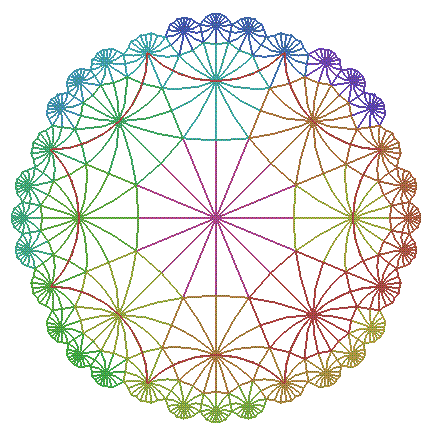Tiling the Poincaré Disk Tiling the Poincaré Disk
The Poincaré disk is a model of non-Euclidean geometry. It is the region inside (but not including) a bounding circle, where straight lines are defined to be either diameters of the bounding circle, or arcs of circles that are perpendicular to the bounding circle. This geometry obeys all of Euclid's postualtes except the parallel postulate. In this geometry, given a line and a point not on that line, there are infinitely many lines through that point which do not intersect the given line. (In the intrinsic geometry of the Poincaré disk, these lines extend indefinitely, even though they appear to us to end at the boundary circle. Also, in this intrinsic geometry, these lines are the shortest distance between two points.)
Recall that in Euclidean geometry, the sum of the angles of a triangle is 180 degrees. Also, Euclidean geometry admits similar triangles, i.e., triangles whose angles are the same but whose sides are not. Given two similar triangles, the first may be blown up or shrunk so it exactly fits onto the second.
Non-Euclidean geometry is completely different in this respect. The sum of the angles of a triangle can be any number (strictly) between 0 and 180 degrees, and there is no such thing as similar triangles. Instead, a triangle is determined up to congruence by its angles (i.e., two triangles with the same angles are exactly the same size.)

© Juha Haataja and Center for Scientific Computing, Finland This figure shows a tiling of the Poincaré disk by triangles with angles 22.5 degrees, 60 degrees, and 90 degrees. All of the triangles in this figure have the same angles, and so are congruent. Indeed, they are all obtained by beginning with any one of them, and successively reflecting it across its sides. (Note that 16 of then meet at every 22.5 degree vertex, 6 at every 60 degree vertex, and 4 of them at every 90 degree vertex.) In this figure, 96 of these basic triangles form the large octagon outlined in color (and the Poincaré disk is also tiled by copies of this octagon). The fact that there is great flexibility in specifying the angles of a triangle leads to the fact that there are infinitely many essentially different ways to tile the Poincaré disk. This has been known since the nineteenth century, and beautiful pictures appear in many old texts. See, for example, R. Fricke and F. Klein, Vorlesungen über die Theorie der automorphen Funktionen.
On the other hand, there are only 17 essentially different ways of tiling the Euclidean plane, or, as we might technically phrase it, there are exactly 17 plane crystallographic groups.
- Steven Weintraub
Welcome to the
Feature Column!
These web essays are designed for those who have already discovered the joys of mathematics as well as for those who may be uncomfortable with mathematics.
Read more . . .
Feature Column at a glance



